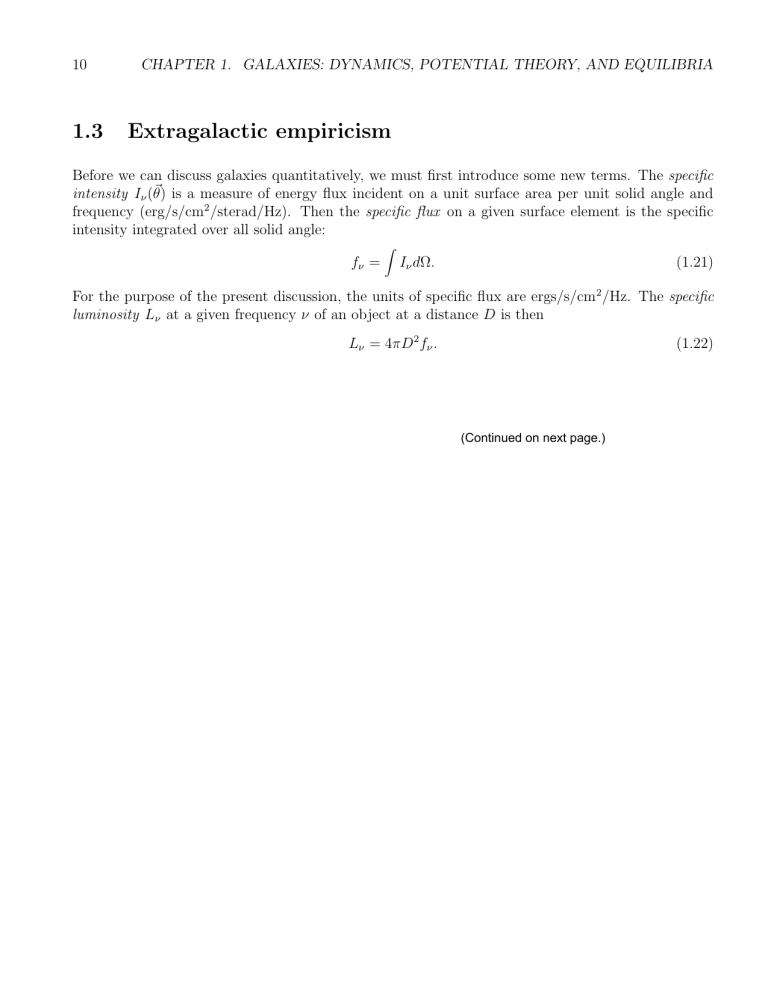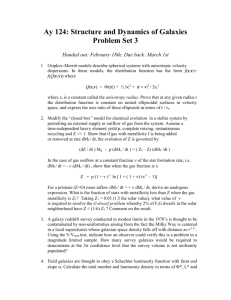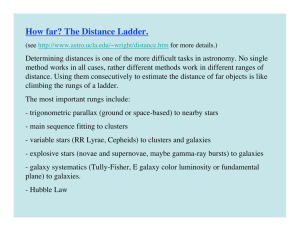1.3 Extragalactic empiricism

10 CHAPTER 1. GALAXIES: DYNAMICS, POTENTIAL THEORY, AND EQUILIBRIA
1.3
Extragalactic empiricism
Before we can discuss galaxies quantitatively, we must first introduce some new terms. The specific intensity I
ν
(
~θ
) is a measure of energy flux incident on a unit surface area per unit solid angle and frequency (erg/s/cm 2 /sterad/Hz). Then the specific flux on a given surface element is the specific intensity integrated over all solid angle: f
ν
=
Z
I
ν d Ω .
(1.21)
For the purpose of the present discussion, the units of specific flux are ergs/s/cm 2 /Hz. The specific luminosity L
ν at a given frequency ν of an object at a distance D is then
L
ν
= 4 πD 2 f
ν
.
(1.22)
(Continued on next page.)
1.3. EXTRAGALACTIC EMPIRICISM 11
Figure 1.11: The observed velocities of nearby galaxies are proportional to their distances, permitting distances to be estimated from Doppler shifts.
Astronomers often use Pogson quantified magnitudes , a logarithmic system to describe the incident flux in a certain frequency bandpass. There are many different variants, but the one that will appeal most to physicists is the “absolute” system with m
AB
≡ − 2 .
5 log f
ν
− 48 .
60 .
(1.23)
The zero points of the various magnitude systems are arbitrary 2 , but they all try, to some extent, to preserve Ptolemy’s scheme of 2000 years ago. The surface brightness µ (in dimensionless units of magnitude per square arcsecond) is then
µ ≡ − 2 .
5 log I
ν
− 48 .
60 − 2 .
5 log(206265) 2 .
(1.24)
Observers will immediately recognize the last quantity in parentheses as the number of arcseconds in a radian (and the number of astronomical units in a parsec). As a matter of convention, the visible and near infrared portions of the electromagnetic spectrum are split up into a number spectral bands that have their origin in recipes for the glass that was used (by Harold Johnson) to construct filters.
In order of increasing wavelength they are called U, B, V, R, I, J, H, and K where the first five letters stand for “ultraviolet”, “blue”, “visual”, “red”, and “infrared”. When giving the luminosity or brightness of a source, one typically specifies a wavelength. For example, the background magnitude of the night sky in the surface density of 100 L
¯
B filter is roughly
/ pc 2 .
µ
B
∼ 22 .
05 B mag
/ arcsec 2 , corresponding to a luminosity
Empirically, it is found that many galaxies obey simple “laws” that give the surface brightness as a function of radius from the galactic center. The best-known of these empirical relations are the
Freeman disk and the deVaucouleurs spheroid :
I ( r ) =
I
0
I
0 exp exp
³ r r s
·
´
− 7 .
67
³ r r e
´ 1 / 4
¸
: Freeman disk
: deVaucouleurs spheroid .
(1.25)
For disks, the central intensity is such that at
For spheroids, the effective radius, the surface brightness is typically µ r e e r = 0, the surface brightness is µ
0
∼ 21 .
5 B mag
/ arcsec 2
, is defined so that half the light lies interior to it. At r = r
∼ 22 .
5 B mag
/ arcsec 2 . These are both very close to the surface
.
e brightness of the background night sky, which is made up primarily of zodiacal light and terrestrial airglow. This makes it relatively difficult to detect low surface brightness (LSB) galaxies, and those given to fretting (or quibbling) might worry that we were missing a large fraction of the universe
2 This particular definition gives a magnitude for the star Vega of m
AB
' 0 at 5556˚
12 CHAPTER 1. GALAXIES: DYNAMICS, POTENTIAL THEORY, AND EQUILIBRIA log
Doppler velocity
VWV
XWX
Figure 1.12: A schematic plot of redshift versus distance for a sample of galaxies. The slope is unity, implying a linear relation. Notice that a few points lie far from the mean. Real data is never pretty.
log distance in failing to find such galaxies. Recent work by Blanton et al. using the Sloan Digital Sky Survey indicate that at most ∼ 5% of the total luminosity density of the Universe might be lurking in galaxies too faint to detect against the surface brightness of the night sky.
In addition to these scaling laws that describe the surface brightness of a single galaxy, there are also a number of relationships that describe how galaxies of different luminosities are distributed throughout the Universe. Unfortunately, intrinsic luminosities cannot be determined without knowing the distance to a galaxy. Distances are difficult to measure. This would be a serious problem were it not for the Hubble relation, which tells us (to first order) that distance is proportional to Doppler shift, D = v/H
0
(see Figure 1.12). The Hubble constant, H
0
, was poorly known until recently.
In the absence of a definitive measure of H
0
, it was absorbed into many results, giving an overall map of the universe with a sliding scale. An example is Schechter’s Law , an empirical expression for the “luminosity function” [# galaxies/unit volume with luminosity between L and L + dL ],
φ ( L ) dL = φ ?
µ L
L ?
¶ α exp
µ
−
L
L ?
¶ d ( L/L ?
) .
(1.26)
Schechter’s law works best for galaxies in the range 0 determined from a fit giving m ?
B
.
= − 19 .
75 + 5 log h , φ ?
003 < L/L ?
< 3 where h 3 Mpc − 3
L ?
( ' 10 10 L
¯ h − 2 ) is
= 2 .
0 × 10 − 2 , and α = − 1 .
09. In each of these parameters, h is the dimensionless expansion factor of the Universe as a fraction of the canonical value for the Hubble constant 3 : h ≡
H
0
100 km / s / Mpc
= v/D
100 km / s / Mpc
.
(1.27)
The luminosity function φ ( L ) has a form often seen in physical processes, a power law dependence with an exponential cutoff, shown schematically in Figure 1.13. Although φ ( L ) diverges for faint galaxies ( L → 0), the integrated luminosity is finite and actually analytic:
Z
φ ( L ) LdL = Γ( α + 2) φ ?
L ?
= (1 + α )!
φ ?
L ?
.
(1.28)
Given the difficulty of measuring absolute distances and magnitudes of galaxies, it is useful to establish that one or another observable property of galaxies is correlated (the more strongly the better) with the intrinsic luminosity of a galaxy. The Tully-Fisher Law for spiral galaxies is one such
3 The best measurements today give h ' 0 .
7, or equivalently, H
0
' (14Gyr) − 1
1.4. POTENTIAL THEORY 13 log # per unit volume
Figure 1.13: A schematic representation of the luminosity function for galaxies, cutting off sharply at the bright end and diverging slowly at the faint end.
absolute magnitude empirical relation, between the circular velocity v c and the total luminosity, L , of a galaxy, with v c
' 250 km / s
µ L
L ?
¶ 1 / 4
(1.29) and the Faber-Jackson Law gives a similar relationship for the line-of-sight velocity dispersion σ los for elliptical galaxie, :
µ L ¶ 1 / 4
σ los
∼ 220 km / s
L ?
.
(1.30)
The fundamental plane relation for ellipticals is an extension of the Faber-Jackson relation to include a dependence upon surface brightness. It is usually expressed in terms of deVaucouleurs’ effective radius r e rather than luminosity, r e
∝ σ 1 .
49 ± 0 .
05 e
I − 0 .
75 ± 0 .
01 e
.
(1.31)
Here effective radius, r e
, depends upon distance, but the velocity dispersion and intensity do not.
Another two techinques for estimating galaxy distances involve the luminosity functions for globular clusters and planetary nebulae within galaxies. Yet another technique (the surface brightness fluctuation method) involves measuring the graininess of the observed surface brightnesses of elliptical galaxies due to the finite numbers of stars in each square arcsecond. The best technique requires patience and luck – observing a supernova within a galaxy.






